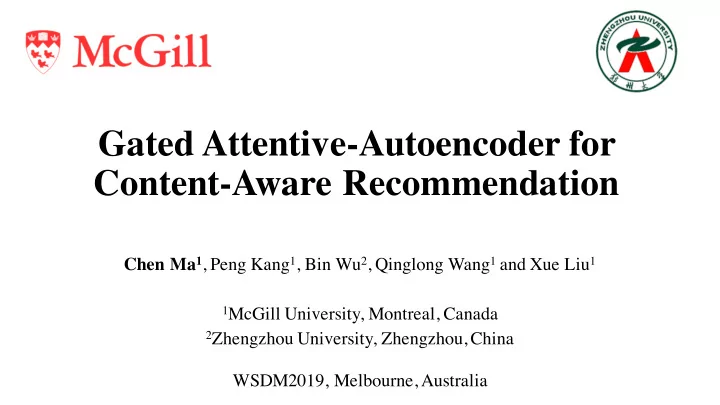

Gated Attentive-Autoencoder for Content-Aware Recommendation Chen Ma 1 , Peng Kang 1 , Bin Wu 2 , Qinglong Wang 1 and Xue Liu 1 1 McGill University, Montreal, Canada 2 Zhengzhou University, Zhengzhou, China WSDM2019, Melbourne, Australia
Background The rapid growth of Internet services allows users to access millions of online products, such as movies, articles. The large amount of user-item data facilitates a promising and practical service – the personalized recommendation . 1
Background The rapid growth of Internet services allows users to access millions of online products, such as movies, articles. user 1 2 3 4 5 movie 1 2 3 4 5 1
Background The rapid growth of Internet services allows users to access millions of online products, such as movies, articles. user 1 2 3 4 5 movie 1 2 3 4 5 1
Background The rapid growth of Internet services allows users to access millions of online products, such as movies, articles. user 1 2 3 4 5 movie 1 I 2 II 3 III 4 5 1
Background The rapid growth of Internet services allows users to access millions of online products, such as movies, articles. user 1 2 3 4 5 movie 1 I 2 II 3 III 4 Content helps 5 Less privacy issue 1
Related Work Models Algorithms • Equally treat item content CTR ( Wang et al., SIGKDD’ 2011 ) MF + LDA • Combine the rating and content SVDFeature ( Chen et al., JMLR’ 2012 ) Feature-based MF information by regularization HFT ( Julian et al., RecSys’2013 ) LFM + LDA CDL ( Wang et al., SIGKDD’2015 ) MF + SDAE • Not explicitly utilize the item- ConvMF ( Kim et al., RecSys’ 2016 ) MF + CNN item relations CVAE ( Li et al., SIGKDD’2017 ) MF + VAE MF: Matrix Factorization LDA: Latent Dirichlet Allocation LFM: Latent Factor Model SDAE: Stacked Denoising AutoEncoder 2 V AE: Variational AutoEncoder
Model Overview An autoencoder -based model: Word-attention Gating layer Neighbor-attention 3
Model Overview An autoencoder -based model: Word-attention Gating layer Neighbor-attention 4
Autoencoder • Autoencoder is used to learn the item hidden representations from rating information. binary item rating vector 4 http://nghiaho.com/?p=1765
Word-attention Module 5
Word-attention Module • Previous works do not discriminate the word importance for describing a certain item • Some informative words are more representative than others and should contribute more to characterize a certain item E.G. • We utilize an attention model to learn the item representation from content information . 5 Lin et al., A Structured Self-attentive Sentence Embedding, ICLR 2017
Word-attention Module word embedding look-up attention score matrix matrix representation of items aggregate item representations into one aspect 5
Gating Layer 6
Gating Layer • Adaptively fuse the hidden representations from two heterogeneous data sources • Avoid tedious hyper-parameter tuning by the regularization term Gating ¡Layer item hidden representations item hidden representations from ratings from content the gated item representation adaptively learn the gate combine hidden representations 6
Neighbor-attention Module 7
Neighbor-attention Module • Previous works do not consider the relations between items • Related items may share the same topic or have similar attributes: citations between articles, movies in the same genre • Exploring users’ preferences on an item’s neighbors also benefits inferring users’ preferences on this item 7
Neighbor-attention Module One-‑hop ¡neighbors … Neighbor_Att the item neighborhood representation use a bilinear function to capture the relation the attention score of item i ’s neighbors the neighborhood representation item i 7
Prediction and Loss • Modified decoder: explore users’ preferences on both an item and its neighborhood • Weighted loss 8
Evaluation • Four datasets For each user, 20% of her viewed items are selected as testing. • Evaluation Metrics • Recall@5, 10, 15, 20 • NDCG @5, 10, 15, 20 9
Evaluation Baselines WRMF: weighted regularized matrix factorization, ICDM’ 2008 Classical CF methods CDAE: collaborative denoising autoencoder, WSDM’ 2016 CDL: collaborative deep learning, SIGKDD’ 2015 CVAE: collaborative variationalautoencoder, SIGKDD’ 2015 Learning from bag-of- words CML+F: collaborative metric learning, WWW’ 2017 ConvMF: convolutional matrix factorization, RecSys’ 2016 Learning from word sequence JRL: joint representation learning, CIKM’ 2017 10
Evaluation Results *: p <= 0.05, ** p < 0.01, ***: p < 0.001 Our GATE outperforms other methods significantly on most of the datasets 11
Evaluation Results • Ablation study From (2), (3): our gating is better than regularization From (3), (4), (5): our word-attention achieves similar performance with fewer parameters From (3), (6): the item-item relations play an important role 12
Evaluation Results • Case Study 13
Conclusion We propose an autoencoder-based model, which consists of a word-attention module , a neighbor-attention module , and a gating layer to address the content-aware recommendation task. Experimental results show that the proposed method outperforms the state-of-the-art methods significantly for content-aware recommendation. 14
Thank you! Q & A Email : chen.ma2@mail.mcgill.ca Google ‘ LibRec ’ Code : https://github.com/allenjack/GATE LibRec : https://www.librec.net/
Recommend
More recommend